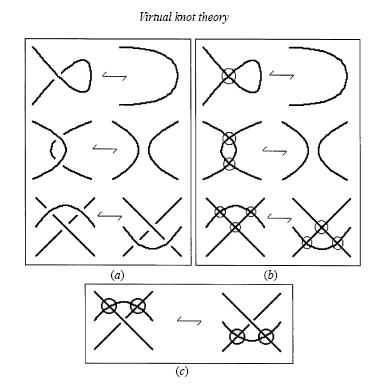Categorification in New Scientist
Posted by John Baez
Here’s an article on knot theory that mentions categorification:
- Richard Elwes, Fundamental secrets are tied up in knots, New Scientist, October 15, 2008.
Richard Elwes is a mathematician and reporter based in Leeds, UK.
Most of the story is about the Jones polynomial and other quantum invariants of knots. I’ll just quote a bit at the end:
Then, in 1999, an exciting breakthrough came — once again from an entirely unexpected quarter. A radically different technique not only spawned a new generation of knot invariants, but also suggested that the mathematics behind knots might have a more profound significance than anyone suspected. The technique’s name was categorification.
Categorification turns the normal guiding logic of mathematics — the abstraction and simplification of the real world — on its head. Abstraction and simplification are all very well, but the results are often too simple to describe as much as we might want. This can be illustrated by the difficulties small children wrestle with when learning to count. Why do three apples and three oranges both reduce to the same “3”, when apples and oranges are entirely different things?
The answer is that the mathematical structure that “3” inhabits - the system of ordinary numbers - is an abstraction shorn of any information about the things it represents. In this case, categorification involves replacing this system with a richer structure, a “category”, in which the rigid equations that define the number system - “1 + 2 = 3”, for example - are replaced with weaker statements comparing the sizes of different sets of objects. This category offers a real-world flexibility that numbers on their own do not: its sets can be different even if they have the same size. In this structure, the original number system appears as the category’s “shadow”, obtained by collapsing all sets of size 3 down to just one representative: the number 3.
Might what works for the number system also work for other mathematical objects? This was the philosophy adopted by Mikhail Khovanov, a mathematician at the University of California, Davis, when he revisited Jones’s invariant in 1999. Instead of breaking it down into smaller finite-type expressions, he looked for some grander structure of which it was just the most visible shadow.
His search was a spectacular success. The overarching category that he found is conceptually difficult, but mathematically it is far less awkward than Kontsevich’s integral, and it’s a more reliable description of a knot than Jones’s formula. Even better, thanks to an ingenious computer program written in 2006 by Dror Bar-Natan of the University of Toronto, Canada, it can now be computed efficiently for any knot, potentially opening up its use to researchers in other areas.
Khovanov’s category is not perfect: there are still instances of knots that share the same category. So work continued and, in 2005, together with Lev Rozansky of the University of North Carolina, Chapel Hill, Khovanov unveiled a new invariant operating at an even higher level. Not only does this categorify many quantum invariants beyond Jones’s, it also subsumes Khovanov’s original category, as well as several other knot invariants discovered in the meantime.
The power of the Khovanov–Rozansky category is getting us close to the perfect knot description, though early indications are that we are not there yet. A still broader family of quantum invariants may yet need to be incorporated before we can say we have the loose ends of the knot problem tied up. Nevertheless, we seem to be edging towards the ultimate mathematical solution.
With early experiments in categorification yielding such riches, physicists and mathematicians are waking up to the idea that the approach might apply to more than just knots. Recalling the deep connection of knots with quantum theory that inspired Jones in the first place, some researchers think they have spotted a tantalising hint that whole chunks of mathematical physics are just shadows of larger categorical structures.
Striking analogies have already been found between the categorical descriptions of quantum mechanics and Einstein’s relativity - the twin theoretical pillars of modern physics that have so far seemed fundamentally incompatible. And John Baez, Alexander Hoffnung and Christopher Rogers of the University of California, Riverside, have recently argued that string theory — a favoured starting point for a theory of everything — can be viewed as a categorification of particle physics.
If a categorification embracing both relativity and quantum theory can be found, then the inconsistencies that physicists see between these two theories might yet prove to be an illusion. Such a tying together of all of physics would indeed be a categorical triumph for the humble knot.
This is the first time I’ve seen a popular science magazine try to explain categorification. Knot theory is a good context for explaining this. A picture of knots that are isomorphic but not equal might help, since anyone can see they’re different but still ‘the same in a way’ — and untying a knot is just proving that it’s isomorphic to the trivial knot.




Re: Categorification in New Scientist
Very interesting. Are there any books on categorification that you would recommend?